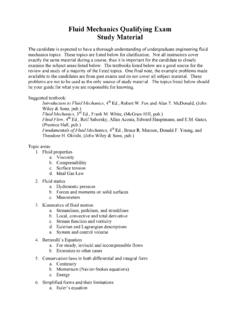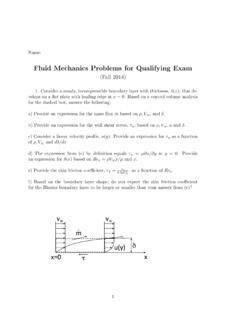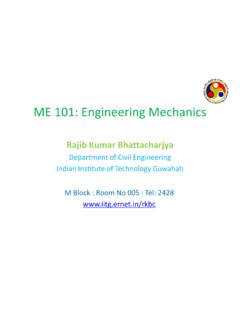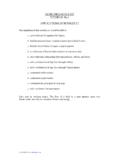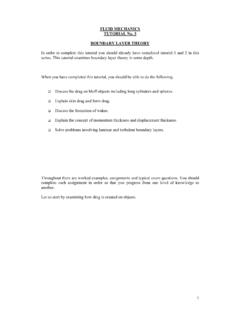Transcription of Fluid Mechanics Study Material - New Mexico State University
1 Fluid Mechanics Qualifying Exam Study Material The candidate is expected to have a thorough understanding of undergraduate engineering Fluid Mechanics topics. These topics are listed below for clarification. Not all instructors cover exactly the same Material during a course, thus it is important for the candidate to closely examine the subject areas listed below. The textbooks listed below are a good source for the review and Study of a majority of the listed topics. One final note, the example problems made available to the candidates are from past exams and do not cover all subject Material .
2 These problems are not to be used as the only source of Study Material . The topics listed below should be your guide for what you are responsible for knowing. Suggested textbook: Introduction to Fluid Mechanics , 4th Ed., Robert W. Fox and Alan T. McDonald, (John Wiley & Sons, pub.) Fluid Mechanics , 3rd Ed., Frank M. White, (McGraw Hill, pub.) Fluid Flow, 4th Ed., Rolf Sabersky, Allan Acosta, Edward Hauptmann, and Gates, (Prentice Hall, pub.) Fundamentals of Fluid Mechanics , 4th Ed., Bruce R. Munson, Donald F.
3 Young, and Theodore H. Okiishi, (John Wiley & Sons, pub.) Topic areas: 1. Fluid properties a. Viscosity b. Compressibility c. Surface tension d. Ideal Gas Law 2. Fluid statics a. Hydrostatic pressure b. Forces and moments on solid surfaces c. Manometers 3. Kinematics of Fluid motion a. Streamlines, pathlines, and streaklines b. Local, convective and total derivative c. Stream function and vorticity d. Eulerian and Lagrangian descriptions e. System and control volume 4. Bernoulli s Equation a. For steady, inviscid and incompressible flows b.
4 Extension to other cases 5. Conservation laws in both differential and integral form a. Continuity b. Momentum (Navier-Stokes equations) c. Energy 6. Simplified forms and their limitations a. Euler s equation b. Laplace s equation 7. Similitude a. Buckingham Pi Theorem b. Dimensional analysis c. Application to correction and modeling 8. 2-D potential flow theory a. Definition of potential flow b. Linear superposition c. Basic potential flow elements 9. Fully developed pipe and duct flow a. Laminar and turbulent flow solution methods b.
5 Moody diagram 10. External flow a. Boundary layer approximations, displacement and momentum thickness b. Boundary layer equations, differential and integral c. Flat plate solution d. Lift and drag over bodies and use of lift and drag coefficients 11. Basic 1-D compressible Fluid flow a. Speed of sound b. Isentropic flow in duct of variable area c. Normal shock waves d. Use of tables to solve problems in above areas 12. Non-dimensional numbers, their meaning and use a. Reynolds number b. Mach number c. Euler number d.
6 Froude number e. Prandtl number Name _____ Spring 2009 Qualifying Exam: Fluid Mechanics CLOSED BOOK 1. The graph below depicts the drag coefficient for a sphere as a function of Reynolds number. A similar relationship is obtained for a very long cylinder in cross flow. Please discuss the various regions as to the flow phenomena taking place. In particular, explain the sudden decrease in drag observed around Re = 300,000 Name _____ Spring 2009 Qualifying Exam: Fluid Mechanics CLOSED BOOK 2. A flow satisfies the following two conditions: a.
7 What does each of these equations represent? b. Given a 2-D flow described by the potential function ( ) ( ) Determine if the above conditions are satisfied. You may use the following equations: ( ) ( ) || || Name _____ Spring 2009 Qualifying Exam: Fluid Mechanics CLOSED BOOK 3. A flat plate of length and height is placed at a wall and is parallel to an approaching wall boundary layer, as shown in the figure below.
8 Assume that there is no flow in the direction and that in any plane , the boundary layer that develops over the plate is the Blasius solution for a flat plate. If the approaching wall boundary has a velocity profile approximated by: ( ) [ ( )] Find an expression for the drag force on the plate. Recall the transformation of variables in the Blasius problem: ( ) ( ) Where is the velocity at the edge of the boundary layer and is the coordinate normal to the plate.
9 Further, ( ) . Name _____ Spring 2009 Qualifying Exam: Fluid Mechanics CLOSED BOOK 4. The momentum and energy equations, in tensor notation, for the Raleigh-Benard problem are as follows: [ ( )] With corresponding to the directions, respectively, and is the Kronecker delta. The variables are the velocity components, , the pressure, , the temperature, . The different parameters in the equations are: , the coefficient of thermal diffusivity, , the coefficient of thermal expansion, , the coefficient of kinematic viscosity, and , a reference density.
10 These equations apply to the Fluid trapped between two parallel rigid walls maintained at fixed temperatures, (lower wall) and (upper wall, with , see figure below. Assume that the Fluid extends to infinity in the and directions. These equations are of course coupled with the continuity equations for incompressible flows. a. Assuming that the base State is one in which the Fluid is at rest and the flow steady everywhere, find the temperature and pressure distributions, ( ) ( ), respectively, in the base State (since wall pressures are not specified, you can leave any constants of integration in the pressure distribution as they are.))
